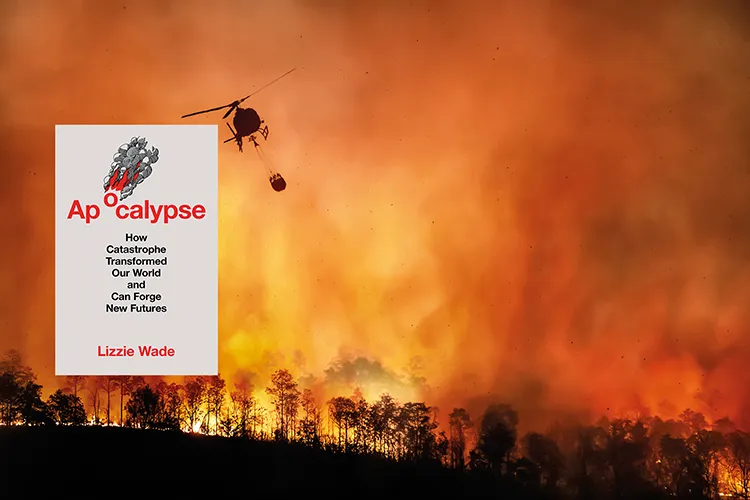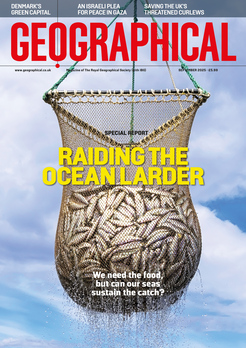
The end is never really the end. Lizzie Wade’s Apocalypse reveals how humanity has long turned catastrophe into transformation—and survival
By Graeme Green
You can’t really blame the Italian poet Petrarch for surveying the devastation caused by the Black Death and coming to the conclusion that ‘the end of the world is at hand.’ The devastating bubonic plague, caused by the bacterium Yersinia pestis and spread primarily by infected fleas on rodents, ravaged Europe, the Middle East, and North Africa in the mid-1300s, causing the horrifying deaths of an estimated 25 to 50 million people. From 1347 to 1351, between 30 to 60 per cent of people in Europe had been wiped out. But, nearly 700 years later, human civilisation is still just about here, if not going strong, then ticking along.
Many people living today, especially younger generations, share Petrach’s anxiety that we’re all heading for disaster from one existential threat or another: war, terrorist attacks, the rise of Right-wing politics, environmental disaster, biodiversity crisis, inequality, poverty, economic crises… But, as Lizzie Wade writes in Apocalypse: ‘People in the past have confronted just about every apocalypse we’re facing today, from megadroughts to plagues, the end of empires to the extinctions of entire human species. What unites those past apocalypses isn’t suffering and death, though those things certainly happened. It isn’t the collapse of social order. It isn’t mass violence. It isn’t the hardening of hearts against outsiders. It isn’t the total loss of hope. What unites them is survival.’
Historians have too often told stories of civilisations impacted by apocalyptic events as cautionary tales, such as the Easter Islanders who cut down all their trees, leading to a decline in the island’s ecosystem. But this kind of thinking is simplistic and far from the full story, Wade argues. Her book’s a deep dive into archaeology and history, a fast-moving account, leaping across time (right back to the Neanderthals) and across the planet, from Spain to Pakistan, Mexico to the UK, combining scientific evidence, facts and theories with imaginative storytelling to bring different case studies to life.
The outcomes of major upheavals have been remarkably varied. In the ancient city of Harappa in Punjab, Pakistan, drought and food shortages caused a welcoming, public-minded city that had once been a thriving economic centre to descend into social breakdown, poverty and violence. As the Black Death spread through Europe, law and order disintegrated and massacres were perpetrated against Jewish populations in Spain and other countries, ‘as Christian communities all over the continent accused their Jewish neighbours of poisoning wells and causing the plagues,’ with attacks also extending to anyone seen as an ‘outsider.’ Impending apocalypse seems to have a way of highlighting and exasperating pre-existing problems in society.
But Wade’s central argument is that the news isn’t all bad and that there are often ‘silver linings’ to times of immense turmoil: ‘Apocalypses are not endings. They are transformations.’ In the case of northern Peru, people living on the coast over 5,000 years ago gradually adapted to floods and other severe environmental challenges caused by regular El Niños to form more harmonious, integrated societies. ‘After a cataclysm, no one was a stranger,’ Wade writes. ‘Those “disparate, damaged groups” found ways to live on previously unused wetlands, to work on building projects using bricks made of clay (provided by the environmental disaster), and ‘began to work together in a new way. The connections and skills learned during recoveries from repeat apocalypses may have taught people to organise themselves, their resources, and their labour for the benefit of all.’ Wade’s point? ‘As far back as we can see, humans have survived apocalypse through cooperation and generosity.’
There are other examples. Before the Black Death, the feudal societies of medieval England were built on economic and social inequality, but after the worst had subsided, the population shift caused by such a dramatic loss of people meant survivors had more freedom and choice, better economic and job prospects, and lived longer, healthier lives than their predecessors. Written during the Covid-19 pandemic, Wade’s glass-half-full approach to history makes the case that humanity, like Gloria Gaynor, will survive, but more importantly that great change is an opportunity for ‘reinvention and renewal.’
This kind of zoomed out overview will come as cold comfort to the millions of people who have suffered, or will soon suffer, very real tragedies brought about by climate catastrophe, conflict, poverty and other 21st century problems. Whether humanity will decide to pull together and create something new and better from the wreckage, or to tear ourselves apart, is the big question. Just as there are people willing to come together for the greater good, there are, as Naomi Klein wrote in The Shock Doctrine, powerful forces (individuals, corporations, governments) working hard to make the most of terrible events, or even creating dire situations in order to profit from them.
But looking at history closely and understanding that ‘We are the inheritors of a long tradition of adaptation and survival’ is useful, Wade argues, an opportunity to think about the future hopefully, not just fearfully.




